4 Creative Pilates: Inspired Exercises That Build Strength and Confidence in Kids
Oct 30, 2025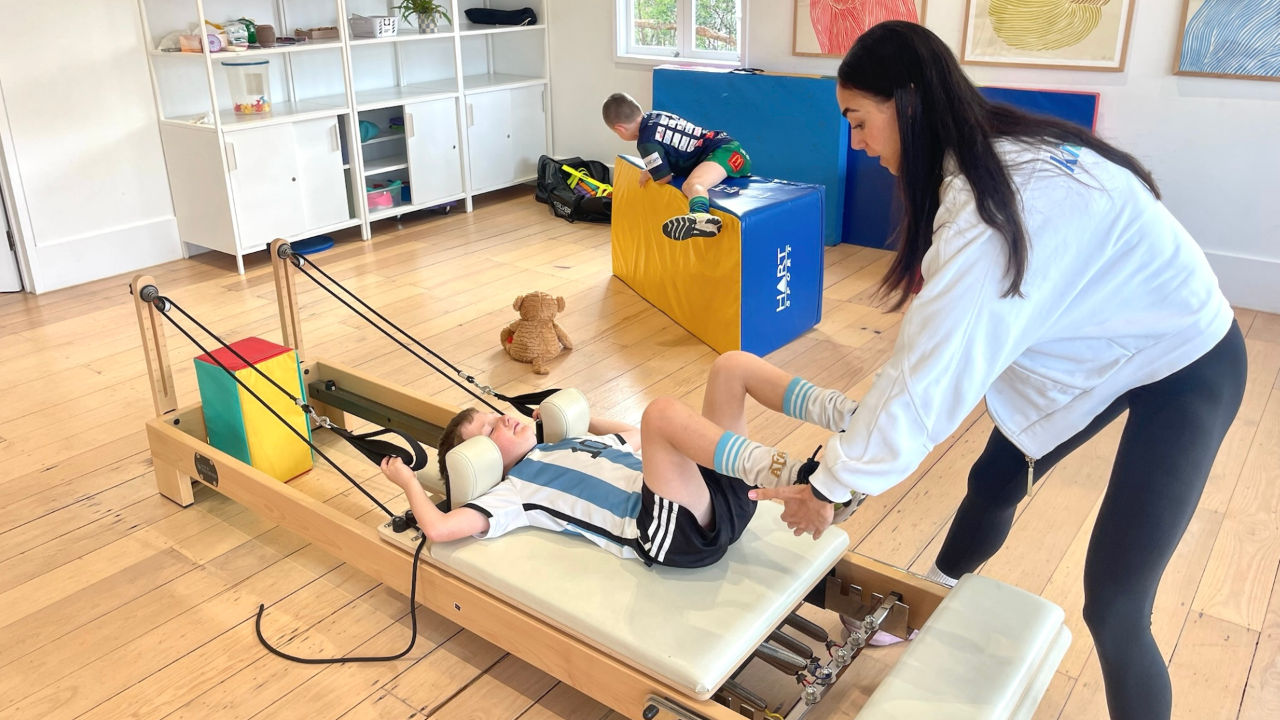
“Every movement tells a story, when we listen, we start to understand the child behind it.”
At Kids Heart Pilates, we believe that movement is more than exercise, it’s how children communicate, regulate, and connect.
Through play-based Pilates and functional movement, we can support children’s growth across every domain: physical, sensory, cognitive, and emotional.
These four playful, purpose-driven exercises are favourites in our sessions and an abbreviated version from my exercise database. They are holistic and build strength, awareness, and confidence, all through imagination and fun.
Reformer Exercise : Pushing the Pancake
Children in our clinic cannot stay off our reformer. They love it! It is fun, can become imaginary.... anything, boat, space ship, car.. you name it. And it is very effective in movement therapy! Here is one of our favourite exercises!
Pushing the Pancake: Side Standing Carriage Pushes
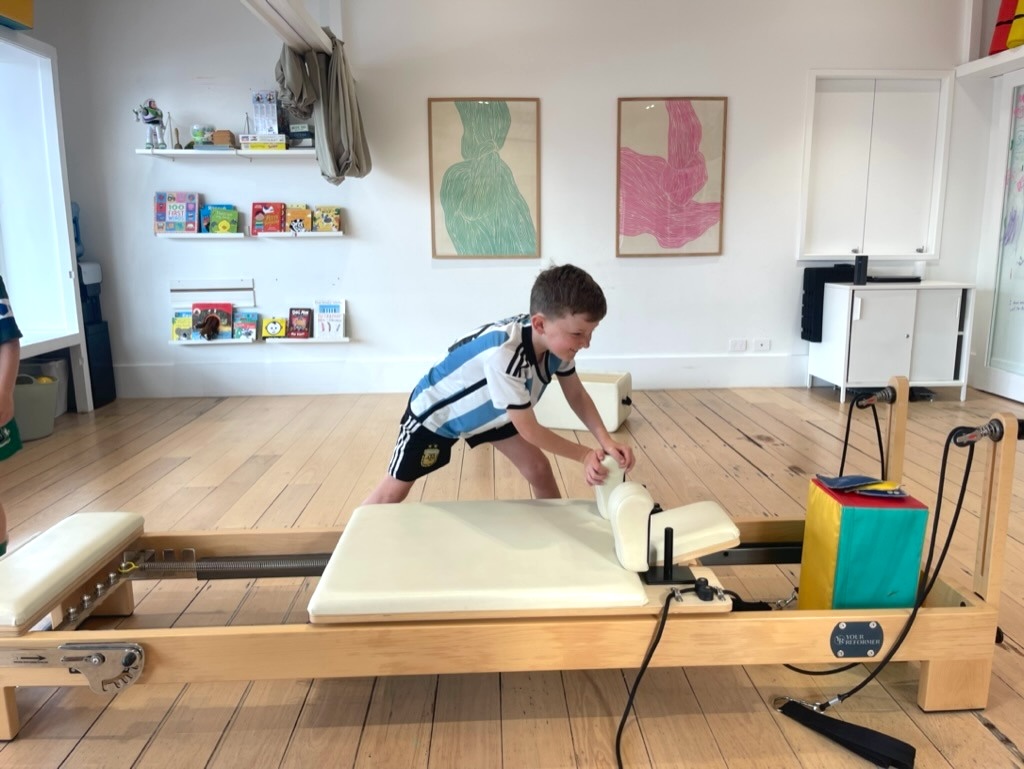
A fun, reformer-based movement that builds strength, coordination, and imagination.
Setting it up
Side Standing Carriage Pushes
- Child stands side-on to the reformer with feet hip-width apart and soft knees.
- Hands rest on the bar or padded block on the carriage.
- Push the carriage away by extending the arms, then return under control.
💡 Tip: Keep the spine tall and the feet grounded!
Paediatric Dialogue Example (Playful Language)
- “We’re flipping the world’s biggest pancake today!”
- “Push it out slowly to cook it evenly.”
- “Keep your feet still like they’re glued to the kitchen floor!”
- “Push… flip… and bring it back. Nice and smooth like syrup!”
Why it matters: Using story-based play keeps kids engaged while building movement
Therapist Cues (PPF Feedback)
- Soft knees and symmetrical stance
- Tall spine and neutral posture
- Smooth, controlled movement
- Shoulder and scapular stability
- Encourage bilateral work (repeat both sides)
Optional Props: toy pancakes, plush food, cooking tools, stickers for movement range
Progressions & Regressions
Progressions:
- Add a spring for resistance
- Introduce a balance pad or soft mat
- Add a timer, “How many pancakes can we flip in 20 seconds?”
Regressions:
- Reduce spring tension
- Support the trunk with a wedge or backrest
- Allow kneeling for more stability
Developmental Benefits
- Motor: Core activation, shoulder stability, coordination, strength
- Sensory: Proprioceptive and tactile input, calming linear motion
- Cognitive: Sequencing, attention, bilateral coordination, motor learning
- Social Emotional: Confidence, turn-taking, pretend play
- Language: Following instructions, describing actions, concept learning
When to Use It
- In upper body or posture-focused sessions
- For children needing proprioceptive or “heavy work” input
- To prepare for desk-based or fine motor activities
- As part of a sensory regulation or calming circuit
Avoid if:
-
Shoulder instability
-
Poor balance control
-
Wrist pain or hypermobility
“Through movement play, we build control, coordination, and confidence.”
Peanut Ball Exercise: Walk the Plank
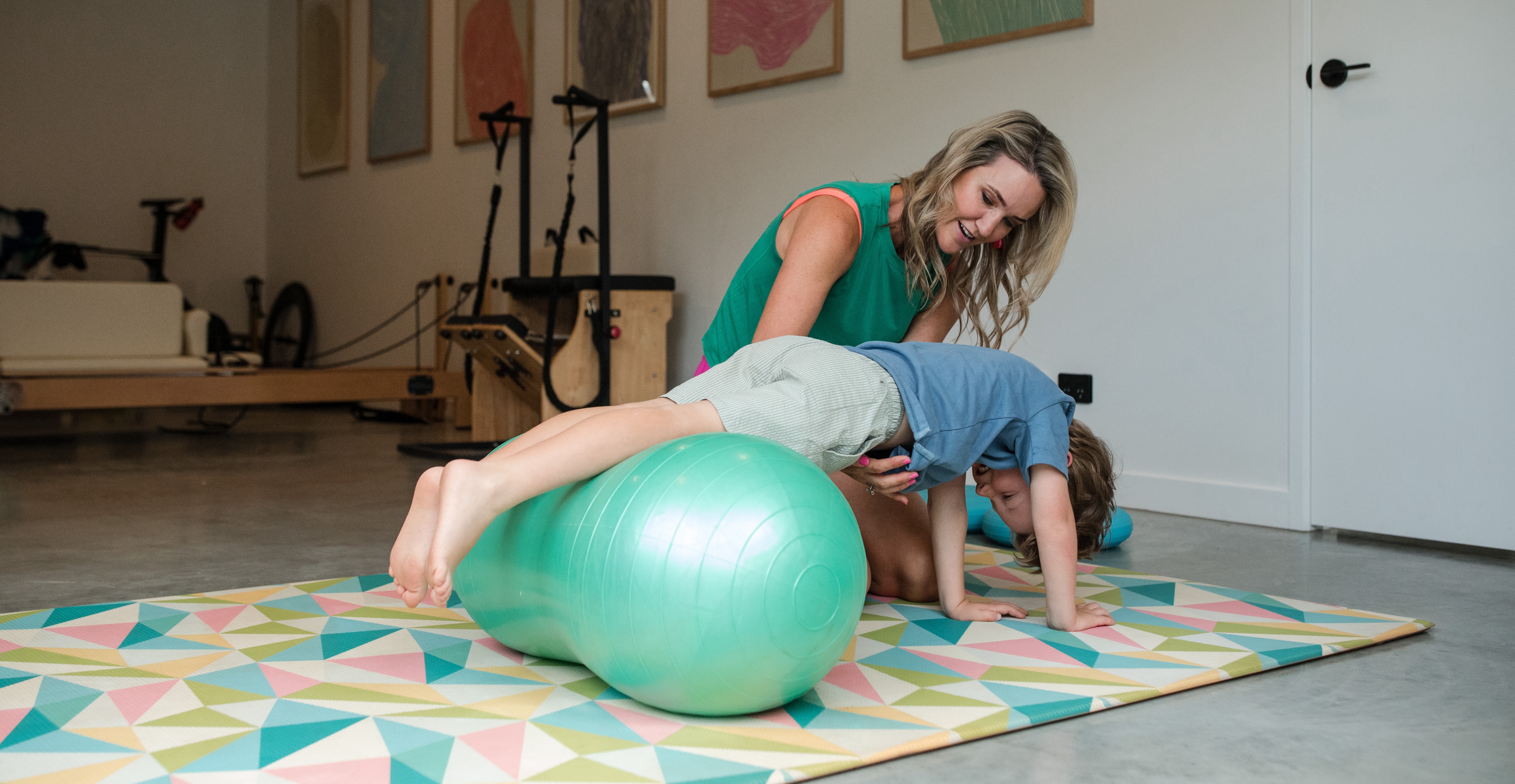
Another fave, as the kids love to play on our peanut balls! We have one in each car and in our clinic. You can use it for assisted jumps, sitting and core strengthe, vestibular sense input and these fun walk outs which is one of our favourites!
Walk The Plank - Progressed walk out.
Building strength, balance, and confidence with movement play.
Setup
- Start crouched behind a large peanut ball with hands on top.
- Slowly roll forward, walking your hands out into a plank position, then walk them back to start.
Focus: controlled movement, shoulder stability, and core engagement.
Playful Dialogue (Paediatric Language)
- “Ahoy there! Let’s walk the plank, pirate!”
- “Creep forward over the peanut boat — walk, walk, walk!”
- “Make your body strong like a bridge!”
- “Hold it… don’t tip overboard!”
- “Now walk your hands back to your pirate island.”
Why it works: Playful storytelling helps children build focus and confidence while working on control and sequencing.
Therapist Focus (PPF Feedback)
- Long spine and hips level
- Controlled hand walking pattern
- Smooth transitions in and out of plank
- Shoulders active and strong
- Slow pacing for core stability
Use: tactile targets, visuals, or a timer to build awareness and motivation.
Progressions & Regressions
Progressions:
- Increase hand-walk distance
- Add a plank hold or small task (tap a cone, grab a toy)
- Try on a soft mat for balance challenge
Regressions:
- Shorten range of walkout
- Support hips or allow knees down
- Use elevated hands for reduced load
Developmental Benefits
- Motor: Core strength, shoulder stability, coordination, endurance
- Sensory: Proprioceptive and vestibular input, body awareness
- Cognitive: Sequencing, attention, bilateral integration
- Social Emotional: Confidence, resilience, imagination
- Language: Following multi-step directions and storytelling
When to Use It
- Whole-body warm-up or sensory motor circuit
- Upper limb and shoulder stability training
- Obstacle course or pirate-themed play
- Regulation and body awareness tasks
Avoid if: poor trunk control, shoulder instability, or pain.
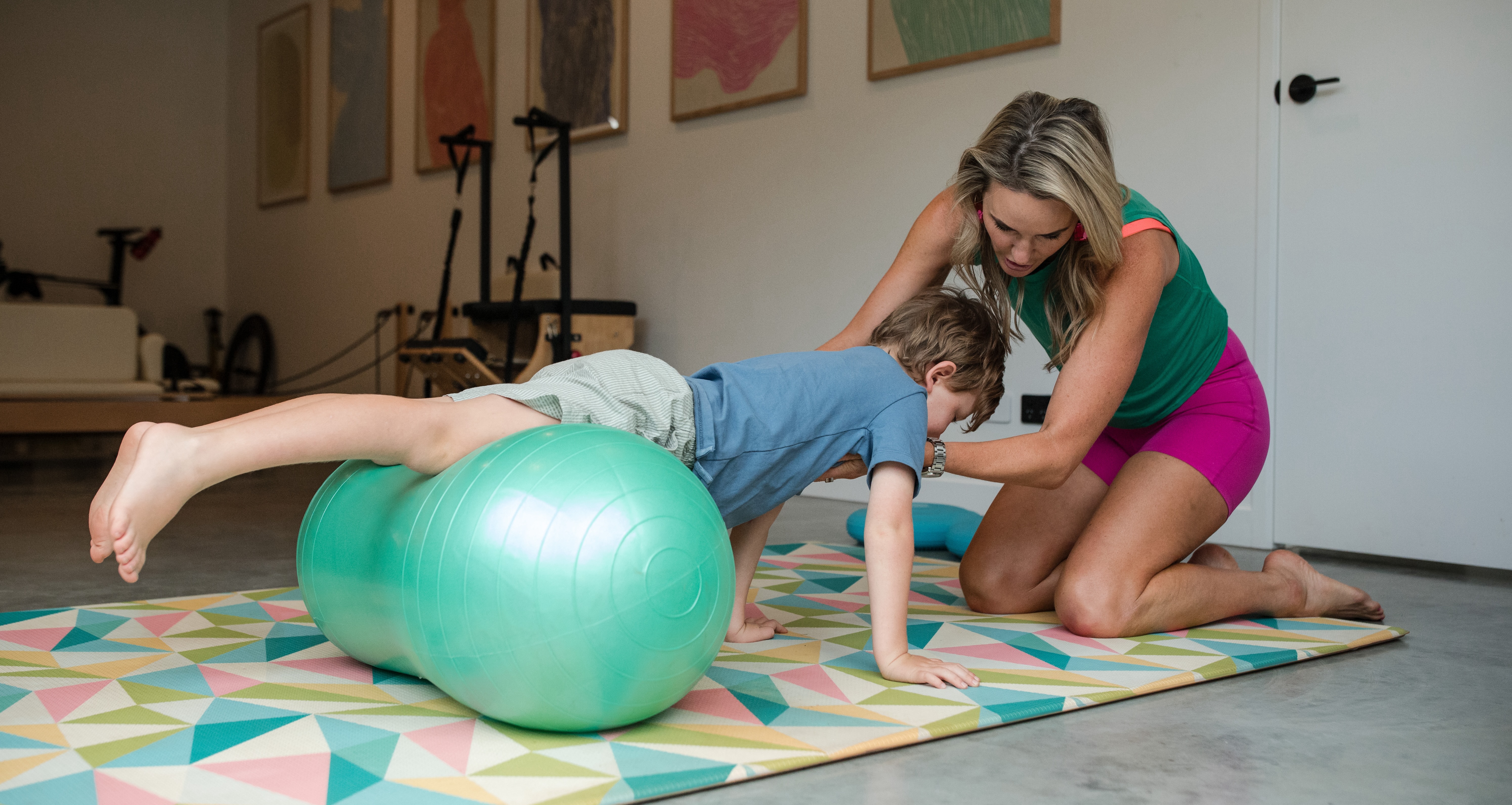
“Movement is a bridge between the body and the brain, the more we move with purpose, the stronger the connection becomes.”
Weighted Ball: Power Shot
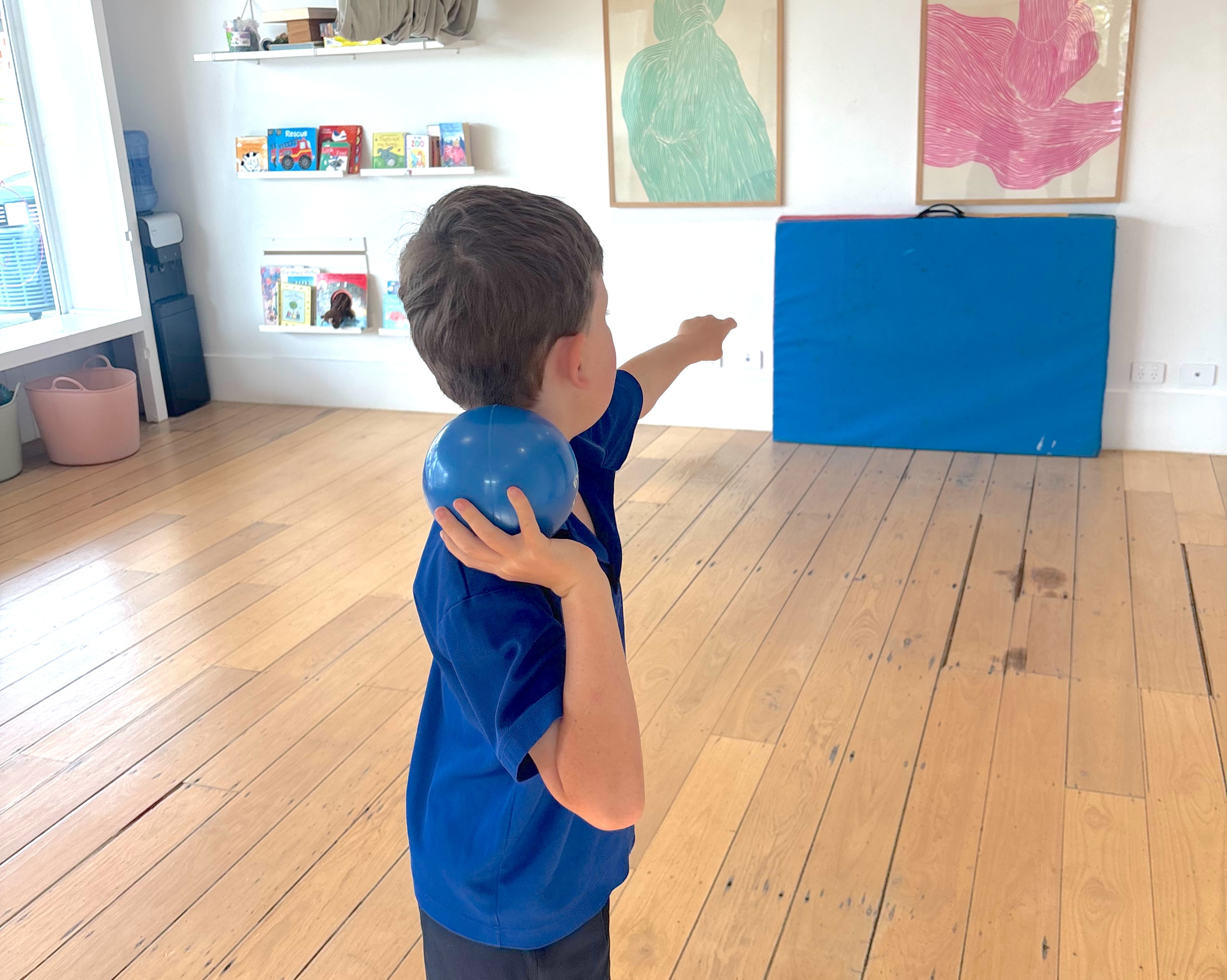
Another one of my go to small apparatus. These are gold for regulation, motor skill development and sensory integration! Another fave for the children in KHP therapy as well. Here is a simple one to try!
Power Shot
Focus: Strength, trunk rotation, visual-motor coordination, and confidence
Build strength, coordination, and confidence with every throw.
Setting Up:
- Child stands on the floor and throws a weighted ball toward a target, a tower, hoop, or basket.
- Focus on trunk rotation, stepping, coordination, and follow-through.
Challenge: try it one-handed, two-handed, or from a balance pad!
Paediatric Dialogue (Playful Language)
- “It’s Power Shot time! Let’s see how far you can launch this ball!”
- “Can you knock down the tower with your super throw?”
- “Step forward like a superhero getting ready to blast off!”
- “How many targets can you hit in 30 seconds?”
Why it works:
Imagery and challenge-based play make kids excited to move while supporting form, focus, and coordination.

Therapist Cues (PPF Feedback)
- Encourage trunk rotation and step-through
- Keep eyes on target for follow-through
- Smooth rhythm: “Ready… aim… throw!”
- Engage core and use full-body motion
- Support balance and alignment on unstable surfaces
Tip: match ball weight to strength and goals.
Progressions & Regressions
Progressions:
- Add distance or resistance
- Throw from a foam pad or BOSU
- Challenge timing or targets
- Alternate hands or throw with eyes closed
Regressions:
- Use lighter balls or beanbags
- Throw from kneeling or seated
- Reduce distance or target size
Developmental Benefits
- Motor: Core and shoulder strength, trunk rotation, balance, hand-eye coordination
- Sensory: Proprioceptive input, visual tracking, tactile feedback
- Cognitive: Sequencing, attention, strategy, motor planning
- Social Emotional: Confidence, teamwork, perseverance
- Language: Following commands, describing actions, concept learning
When to Use It
- In throwing and catching circuits
- Warm-up for trunk and upper limb activation
- In group games or goal-directed sessions
- To develop balance, focus, and visual-motor skills
Avoid if: shoulder instability, poor postural control, or limited endurance.
“When children see themselves succeed through movement, their confidence grows — that’s the real win.”
Floor Exercise: Mermaids and Mermen
I am a sucker for a floor exercise. I find that it is really grounding for children to be on the floor and moving with their breath slowly and mindfully. If I have children that are dysregulated getting them down on the floor is one of my first strategies and this is a great exercise with a long list of benefits.
Mermaids & Mermen
A playful stretch to build flexibility, coordination, and confidence.

Setup & Dialogue
Setup:
Sit on your bottom with knees and feet together, both feet to one side.
Dialogue:
- “We’re mermaids and mermen today! What do mermaids have? Tails!”
- “Bring your tails to one side and reach toward them.”
- “Now reach away from your tail, stretch like you’re swimming through the sea!”
Progress to coming up onto knees as they get stronger and more balanced.
Therapist Focus (PPF Highlights)
- Encourage upright posture and even weight through hips
- Cue for reaching through the side body with control
- Support shoulder stability and spinal alignment
- Watch for crossed legs or hip rotation
Focus: Flexibility, coordination, shoulder and core stability, body awareness.
Progressions & Regressions
Progressions:
- Lift onto knees and reach away from feet
- Add breathwork or hold the stretch longer
Regressions:
- Perform with legs crossed for comfort and support
- Keep range of motion small and gentle
Avoid if: spine, oblique, or hip rotator injuries, or significant hypermobility.
Developmental Benefits
Motor: Core activation, spinal mobility, hip strength, coordination
Sensory: Proprioceptive feedback, vestibular control, regulation through rhythmic movement
Cognitive: Bilateral integration, sequencing, imagination and problem solving
Social Emotional: Confidence, self-expression, turn-taking, positive peer play
Language: Following directions, using descriptive and imaginative vocabulary
When to Use It
- Core stability or flexibility sessions
- Sensory circuits or calm-down routines
- Creative movement or storytelling sessions
- Group play with peer encouragement
Why we love it:
It builds strength and regulation while inviting creativity, imagination, and connection.
“When movement feels like play, children discover their strength without even realising they’re working.”
Why These Movements Matter
Each of these exercises is more than just physical, it’s developmental, emotional, and social.
They invite children to move with intention, imagination, and awareness.
When we look closely, we can see how movement connects every system of development:
-
Motor: building control, coordination, and endurance
-
Sensory: helping children regulate, focus, and feel grounded
-
Cognitive: developing sequencing, timing, and problem solving
-
Social Emotional: building self-esteem, resilience, and connection
-
Language: promoting storytelling, descriptive skills, and comprehension
Every exercise is an opportunity to learn about the body, the brain, and the power of play.
💡 Ready to Learn More?
Check out my courses where you can get my entire exercise database!
- CDPP : Child Development and Paediatric Programming: understanding the why and the how 10 ESSA Points
- PFP: Pilates for Paeds: Pilates for Child Development & My exercise database 10 ESSA Points
- Knowledge Corner: My course bundle of the above and absolutely everything on my website 20 ESSA Points

